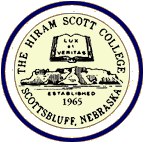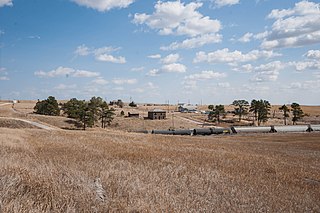Related Research Articles

Chadron is a city and the county seat of Dawes County, Nebraska, United States, in the Great Plains region. The population was 5,851 at the 2010 census. This city is the location of Chadron State College.

The Illinois Central Railroad, sometimes called the Main Line of Mid-America, was a railroad in the Central United States, with its primary routes connecting Chicago, Illinois, with New Orleans, Louisiana, and Mobile, Alabama, and thus, the Great Lakes to the Gulf of Mexico. A line also connected Chicago west to Sioux City, Iowa (1870). There was a significant branch to Omaha, Nebraska (1899), west of Fort Dodge, Iowa, and another branch reaching Sioux Falls, South Dakota (1877), starting from Cherokee, Iowa. The IC also serviced Miami, Florida, on trackage owned by other railroads.
John Earl Fetzer was a radio and television executive who was best known as the owner of the Detroit Tigers from 1961 through 1983. Under his ownership, the 1968 Tigers won the World Series.

The Chicago, St. Paul, Minneapolis and Omaha Railway or Omaha Road was a railroad in the U.S. states of Nebraska, Iowa, Minnesota, Wisconsin and South Dakota. It was incorporated in 1880 as a consolidation of the Chicago, St. Paul and Minneapolis Railway and the North Wisconsin Railway. The Chicago and North Western Railway (C&NW) gained control in 1882. The C&NW leased the Omaha Road in 1957 and merged the company into itself in 1972. Portions of the C. St. P. M. and O. are part of the Union Pacific Railroad network. This includes main lines from Wyeville, Wisconsin, to St. Paul, Minnesota, and St. Paul to Sioux City, Iowa.

Contention City or Contention is a ghost mining town in Cochise County in the southeastern part of the U.S. state of Arizona. It was occupied from the early-1880s through the late-1880s in what was then known as the Arizona Territory. Only a few foundations now remain of this boomtown which was settled and abandoned with the rise and fall of silver mining in and around the area of Tombstone.
The Horonai Railway was a Japanese government-managed railway which was among the first to be built in Hokkaidō. Established in 1869, it was sold off to the private sector twenty years later. Some of the infrastructure of the Horonai Railway remains in use today, as the Temiya Line and Muroran Main Line, connecting Minami-Otaru Station and Iwamizawa Station; these began operations in the 1880s.

Hiram Scott College was a private liberal arts college that operated from 1965 to 1972 in Scottsbluff, Nebraska. Named after Hiram Scott (1805–1828), a fur trapper with the Rocky Mountain Fur Company who was found dead in the vicinity on his return trip from a fur expedition, the institution was one of several Midwestern colleges established by local civic leaders with the support of Parsons College in Fairfield, Iowa. These Parsons "satellite schools" were by-products of the strong growth and apparent success of Parsons during the late 1950s and early 1960s, and all followed the "Parsons Plan" academic model developed at that school. None of the schools, however, were ultimately successful.
William A. Paxton was an American pioneer businessman and politician in Omaha, Nebraska. His life as a rancher and cattleman early in his life, as well as early work with the Union Pacific Railroad was highly regarded among his contemporaries; his success as a businessman later in his life led him to great wealth. His leadership is seen as an essential factor in Omaha becoming a prominent stockyards and meatpacking center. He is frequently referred to as "the real founder of South Omaha."
The Sioux City and Pacific Railroad was a railroad in the U.S. states of Iowa and Nebraska. Built as a connection from Sioux City, Iowa to the Union Pacific Railroad at Fremont, Nebraska, it became part of the Chicago and North Western Railway system in the 1880s, and is now a main line of the Union Pacific (UP). The east–west portion from Fremont to Missouri Valley, Iowa, is the Blair Subdivision, carrying mainly westbound UP trains, and the line from California Junction, Iowa north to Sioux City is the Sioux City Subdivision.
Crawford Hill is a helper district with an average 1.55% eastbound grade between Crawford, Nebraska, United States, at an elevation of 3,678 feet (1,121 m), and Belmont, Nebraska at 4,499 feet (1,371 m) on the BNSF Railway Butte Subdivision. Crawford Hill climbs the Pine Ridge escarpment—formations of buttes and grassy dense sand hills lined with ponderosa pines. Manned helper engines based in Crawford are used to help 18,000-ton loaded coal trains from Wyoming's Powder River Basin up the escarpment.
Fort Niobrara (1880–1906) was a military post located in north central Nebraska.

Belmont is a semi-ghost town in Dawes County, Nebraska, United States, approximately 11 miles (18 km) southeast of Crawford. Originally known as Evergreen City, the settlement was existent by summer 1889, due to the construction of the Belmont Tunnel. However, when the town site was surveyed in 1890, only five blocks were sold. Belmont reached its population peak of around eighty residents in the late 1920s. The trend of declining population started with the Great Depression and accelerated with changes in transportation. Improved vehicles meant that shopping and selling of farm products could be done in larger towns nearby, and the Burlington Railroad ceased passenger service in 1969.
Andrews is an unincorporated community in Sioux County, Nebraska, United States.
Glen is an unincorporated community in Sioux County, Nebraska, United States. It was named for the surrounding glen.
Montrose is a former village in Sioux County, Nebraska, United States. The townsite is located near the intersection of the Powder River Trail and the Cheyenne & Black Hills Stage Road and is now a part of the Oglala National Grassland. All that remains of the town is the historic Immaculate Conception Catholic Church, built there in 1887.
Story is an unincorporated community in Sioux County, Nebraska, United States.
Covington is a ghost town in Dakota County, Nebraska, United States. It is now incorporated into South Sioux City, Nebraska.
Seney is an unincorporated community in Plymouth County, in the U.S. state of Iowa.
Leeland is a former railway hamlet in the Amargosa Valley in Nye County, Nevada. A year after its founding in 1906, a railway station was opened. Raw materials from the nearby Californian mining village Lee were brought to Leeland to be transported by train.

The Chicago and North Western Office Building/Passenger Depot-Lake City, also known as the Lake City Depot, is a historic building located in Lake City, Iowa, United States. The Toledo & North Western Railroad (TNW) laid the first tracks through town in 1881–1882. Because Lake City was already established, they built a two-story, frame, combination depot and the southeast edge of town. Because of its convenient location, the TNW also built their repair and maintenance shops in Lake City in the 1880s. They placed their division headquarters here in 1887. The Chicago and North Western Railway (CNW) acquired controlling interest in the TNW in June 1881, and ran it separately until it formally acquired it in 1890.
References
- ↑ U.S. Geological Survey Geographic Names Information System: Orella, Nebraska
- ↑ "Sioux County". Jim Forte Postal History. Retrieved August 23, 2014.
- ↑ Fitzpatrick, Lillian L. (1960). Nebraska Place-Names. University of Nebraska Press. p. 137. ISBN 0-8032-5060-6. A 1925 edition is available for download at University of Nebraska—Lincoln Digital Commons.
